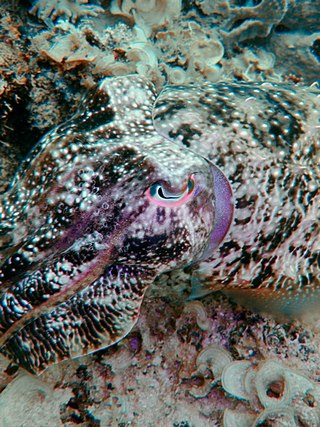
Sepia latimanus, also known as the broadclub cuttlefish, is widely distributed from the Andaman Sea, east to Fiji, and south to northern Australia. It is the most common cuttlefish species on coral reefs, living at a depth of up to 30 m.

The common cuttlefish or European common cuttlefish is one of the largest and best-known cuttlefish species. They are a migratory species that spend the summer and spring inshore for spawning and then move to depths of 100 to 200m during autumn and winter. They grow to 49 cm in mantle length (ML) and 4 kg in weight. Animals from subtropical seas are smaller and rarely exceed 30 cm in ML.

The pharaoh cuttlefish is a large cuttlefish species, growing to 42 cm in mantle length and 5 kg in weight. It is also known as seiche pharaon.
Sepia angulata is a species of cuttlefish native to the southeastern Atlantic Ocean, from Bloubergstrand to Still Bay. It is known only from cuttlebones. The validity of S. angulata has been questioned.
Sepia bartletti is a species of cuttlefish native to the western Pacific Ocean. It is known only from the type locality. Depth range is unknown. Some authorities regard S. bartletti as a nomen dubium.
Sepia baxteri is a species of cuttlefish native to the southwestern Pacific Ocean, specifically the waters around Lord Howe Island. It is known only from the type cuttlebones. Depth range is unknown.
Sepia insignis is a species of cuttlefish native to the southwestern Indian Ocean, specifically South Africa, from the Cape of Good Hope to Natal. It lives at depths to 42 m.
Sepia ivanovi is a species of cuttlefish native to the southwestern Indian Ocean, probably throughout southeast Africa, including Kenya, Mozambique, to the mouth of the Zambezi River. It lives at depths to 50 m.

Sepia mestus, also known as the reaper cuttlefish or red cuttlefish, is a species of cuttlefish native to the southwestern Pacific Ocean, specifically Escape Reef off Queensland to Murrays Beach off Jervis Bay. Reports of this species from China and Vietnam are now known to be misidentifications. S. mestus lives at a depth of between 0 and 22 m.

Sepia novaehollandiae is a species of cuttlefish native to the southern Indo-Pacific. Its natural range stretches from Shellharbour, New South Wales to North West Shelf in Western Australia. It lives at depths of between 15 and 348 m.
Sepia australis, the southern cuttlefish, is a species of cuttlefish which is found in the eastern South Atlantic Ocean and the western Indian Ocean off the coasts of Southern Africa, possibly extending into the waters off East Africa.
Sepia peterseni is a species of cuttlefish native to the western Pacific Ocean. Its natural range stretches south of central Honshū to southern Kyūshū, and it is also present in South Korea. It lives on the inner shelf at depths of between 20 and 100 m.
Sepia pulchra is a species of cuttlefish native to the southeastern Atlantic Ocean, specifically off the Cape Peninsula in South Africa. It lives at depths of between 15 and 50 m.
Sepia reesi is a species of cuttlefish native to the southeastern Indian Ocean. Cuttlebone of this species known only from the type locality.

Cuttlefish or cuttles are marine molluscs of the order Sepiida. They belong to the class Cephalopoda which also includes squid, octopuses, and nautiluses. Cuttlefish have a unique internal shell, the cuttlebone, which is used for control of buoyancy.

Sepia prashadi, common name hooded cuttlefish, is a widely distributed species of cuttlefish. It has a thin, oval body and grows from 5 to 11 cm. The tips of the tentacles have a distinct club shape. S. prashadi is a migratory, demersal cuttlefish living in shallow waters at depths of approximately 40 to 50 metres. It is found in many locations including the east coast of Africa, around India, in the Red Sea, and Persian Gulf.
Sepia braggi, the slender cuttlefish, is a species of cuttlefish native to the Indo-Pacific Ocean. It has been found in coastal waters of southern Australia. This species was first collected in South Australia by its namesake, William Lawrence Bragg. Sepia braggi was then described by Sir Joseph Cooke Verco in 1907.Sepia braggi is part of the subgenus Doratosepion which contains to 41 species of cuttlefish in total.

Sepia elegans, the elegant cuttlefish, is a species of cuttlefish in the family Sepiidae from the eastern Atlantic Ocean and the Mediterranean Sea. It is an important species for fisheries in some parts of the Mediterranean where its population may have suffered from overfishing.
Sepia bertheloti, the African cuttlefish, is a species of cuttlefish from the family Sepiidae which is found in the warmer waters of the eastern Atlantic Ocean off Africa.
Sepia hierredda, the giant African cuttlefish, is a species of cuttlefish from the family Sepiidae, which was previously considered conspecific with the common cuttlefish Sepia officinalis. It is found along the western coast of Africa and is an important species to fisheries.









